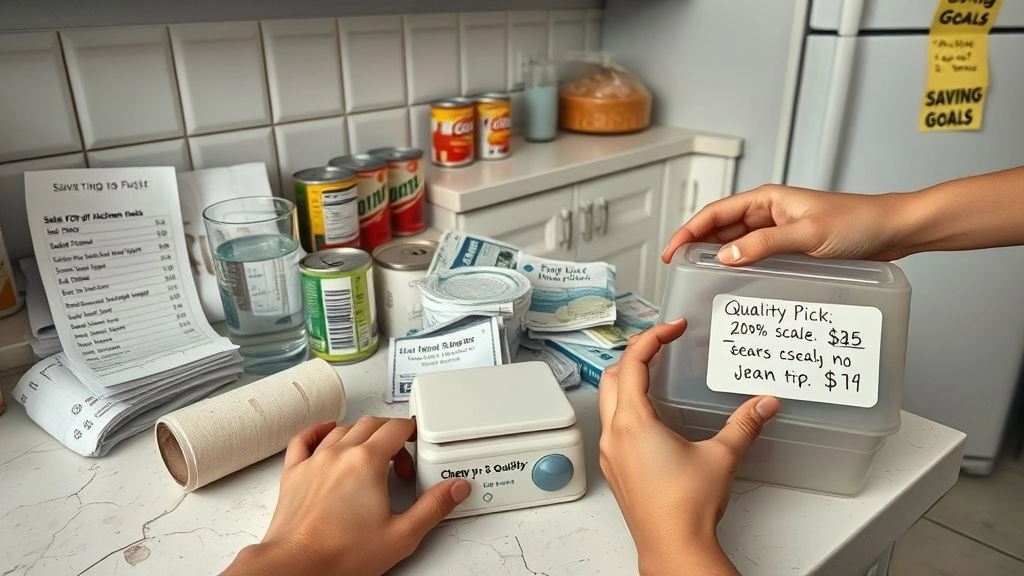Let’s just put it out there: Sometimes you’re convinced you’re nailing this whole frugal life thing… then you look at your bank account and think, “Wait, didn’t I do everything right?” (Been there. Maybe… last week, even.) It’s wild how normal habits—like grabbing sale stuff because “such a good deal!” or obsessing over cents saved—can actually drain your savings instead of protecting them.
So let’s break the cycle. I’m sharing the most common frugal living mistakes that trip us up (yep, these are from actual screwups—mine and others’), ways to sidestep them, and the sneaky ways frugality can boomerang. Ready to save for real this time? Let’s chat.
Dollars with No Job
Ever Feel Like Your Paycheck Just… Disappears?
Picture this. You finally manage to stash away a couple thousand bucks—you swear you’ll only touch it if, say, your water heater explodes. But then, a minivan with a discount pops up, the seats look dreamy, and you think, “We could use this!” Next thing you know, your hard-earned savings? Gone. (Yes, I learned this one the hard way.)
Here’s the thing: Money with no job just sits there, whispering temptations. When you don’t assign every dollar a role—groceries, bills, an emergency fund, even fun treats—it sort of mutinies and finds a way to vanish. I used to put cash in savings and think, “Done!” But then Target’s seasonal aisle calls and… poof.
Table: Before & After “Every Dollar Has a Job”
| Before | After |
|---|---|
| Paycheck drifts into “general savings,” vanishes on impulse buys | Paycheck split into: bills, future needs, fun (even $20 for tacos!) |
| “Wow, where’d that $500 go?” | “Hey, I can cover my car insurance and still have splurge money.” |
My real unlock? Put a sticky note on the savings jar. “This $400 is for the dentist. Hands off.” Or, if you’re more digital, set up separate savings categories. Turns out, the old-school frugal habits to save money are still genius, especially if you give every dollar a job.
No Real Goals
Are You Saving… But Don’t Know What For?
Let’s just admit it: Saving “just because” is kind of like wandering the grocery store without a list when you’re hungry—dangerous, a little aimless, and prime territory for mystery expenses. You wanted to save for a trip. But suddenly your savings turns into new gadgets, random Amazon finds, or… I don’t know, weighted blankets? (I have three. No regrets. Maybe one regret.)
Setting clear financial goals puts a face on your savings. Instead of “save more”—make it “put $1,000 toward Japan trip by next May” or “knock $500 off student loans this quarter.” I literally write mine on sticky notes near my coffee mug. And you know what? I actually get somewhere. Otherwise, it’s just dream math.
Quick Goal-Setting Check-In
| Fuzzy “I’ll save more” | Specific “mini-goal” |
|---|---|
| “Maybe I’ll travel. Someday.” | “Japan, May 2026: $1,400 total. $350/quarter.” |
| “Extra in savings, just in case.” | “Fund for car repairs. $50/month auto-transfer.” |
You want unusual frugal tips? Here’s one: set “anti-goals.” I do NOT want to ever pull out a credit card for a dental bill again. So, I set mini-sinking funds for all my “no way, not again” problems.
Sale FOMO
Is Every Deal Really Worth It?
Anyone else get the sale shakes? (That moment when you see “50% OFF—today only!” and suddenly want five you-didn’t-even-know-existed kitchen gadgets?) Been there, a lot. We all have friends who’ve stacked up tissues, canned beans, or shampoo for “the deal”—only to realize, six months later, they don’t even like that shampoo.
What are common frugal living mistakes? This one: thinking if it’s on sale, you’re saving money… when really, you’re just shifting your spending from one “need” to way-too-many “wants” (that then become guilt clutter).
Spot the Sale Trap
- You buy something because it’s a deal, not because it’s a want or a need.
- Your pantry teeters with stockpiles you’ll never use before they expire.
- Savings? Not so much…
I had a friend who clipped and stacked coupons like a wizard. At first, impressive. But then her “savings corner” (honestly, it was a whole closet) ballooned with soap, condiments… then expired. She calculated her “savings” versus what she’d actually used—ouch. Don’t fall for the “too much of a good deal” bridge, as explained in insights from classic frugal mistakes newbies make.
Want to make this habit even more intentional? Next time there’s a deal, make yourself a rule: Only buy it if you already needed it before seeing it on sale. (If this feels impossible—try it for 30 days. It changed my Target runs, promise.)
Cheap vs. Smart
Does Buying Cheap Really Save You?
Tell me if this sounds familiar: you buy discount paper towels, but they’re so flimsy you use twice as many—so did you save? Often, super cheap stuff ends up costing more (or just driving you bananas).
My personal weak spot: discount tech. Bought a dirt-cheap phone charger three times before I caved and bought the “good” one. Guess which one’s still working.
Choosing the lowest price doesn’t always equal winning frugality. Sometimes, it’s the fastest way to blowing a budget on replacements. As pitfalls of frugality to avoid wisely puts it, “Being frugal doesn’t necessarily mean always choosing the cheapest option. Sometimes, investing in a high-quality product that lasts longer can be more cost-effective in the long run.”
Table: Cheap vs. Quality (From Real Life)
| Cheap Option | Quality Pick |
|---|---|
| $12 shoes – “great deal!” … lasted 4 months (sigh) | $45 shoes – wore for 2 years, feet happy, no replacements |
| Amazon basics kitchen scale, broke before Thanksgiving | Slightly pricier brand, still working after 3 years |
Want another angle? Try focusing less on what is a frugal habit (like “always go generic!”), and more on the why: Pick the cheaper version when experience says it’s just as good. Upgrade for basics you use daily. If you need more inspiration, check out what is a frugal habit? for ideas.
Obsessing Over Pennies
Are You Spending Hours to Save Cents?
Let’s talk time for a second. I used to make my own bread, pasta, and even—get this—laundry soap. At first, I felt like a money-saving superhero… until I realized I was trading whole Saturday afternoons for a few bucks saved. Some folks love the process itself (shoutout, if that’s you!). But if you’re only doing it for the pennies, whoa—let yourself off the hook.
Here’s a question: What could you earn by picking up a gig, or just reading a good book, in that time instead? Being frugal should make your life fuller, not just busier. That’s a lesson I learned after, yes, yet another session pulsing soap flakes in the food processor. Sometimes the old-school, low-effort route works better. For more on finding the right balance, the post on what does a frugal lifestyle look like? has good motivation.
No Plan for Surprises
Do Irregular Bills Wreck Your Budget?
Budget is looking tight, you’re feeling in control… suddenly, BAM—oil change, school photos, grandma’s birthday gift. (Or worse, a vet emergency; don’t get me started.) Happens every. Single. Month.
I used to get totally blindsided until I started a “weird stuff fund”—just a little stash for all that unpredictable chaos. The classic advice? Put aside 5% of what you bring in for “miscellaneous.” It won’t be perfect, but at least you’re not scrambling for the credit card.
Some folks put car repairs, gifts, “oh shoot, I forgot taxes!” in separate sinking funds. Up to you—just plan for the unpredictables. That’s advanced frugal living, honestly … and gives you some room for unusual frugal tips too.
Stingy, Not Frugal
Are You Depriving Yourself or Others?
One huge frugal living myth: Saving money means cutting out all fun. Not true, and actually, not smart! When I went through my brief phase of “no fun, just save”—refusing to go out with friends, skipping every small treat—I started to resent those savings, making me more likely to blow it all at once (hello, pizza binge).
Plus, frugality isn’t an excuse to stop giving or under-tip. Relationships matter. Recurring advice in dollar stretcher’s guide on frugality: don’t confuse smart saving with stinginess. Being “too frugal” can make you less generous, strain relationships, and just suck the joy out of life. Find that balance.
What does a frugal lifestyle look like? Ideally, it means you can be generous and relaxed in small ways because you’re intentional elsewhere. Cake and eat it too, right?
Table: Frugal vs. Cheap (Real Talk)
| Frugal Way | Cheap Mistake |
|---|---|
| Brings snacks to movies, still pays to see in theaters | Refuses outings with friends, sits at home scrolling “free” |
| Treats family to home-cooked meal plus dessert | Insists on skipping family dinners—”it costs too much” |
So, What’s Next? (Your Turn!)
Dang, that’s a lot of lessons. But honestly, most of us have crashed headfirst into one—or all—of these frugal living mistakes. The truth is, what are common frugal living mistakes? It’s stuff that feels normal but quietly sabotages your bigger financial dreams. Now you know to watch out for no-purpose savings, sale FOMO, and the low-quality trap, you’re that much closer to turning your efforts into real results—not just busywork.
You don’t need everything on this list perfect today. Maybe try giving each dollar a job this week, or write out three “I will not be caught off guard by this expense again” mini-goals. Or, hey, give yourself a pass on one thing you hate doing (use that time to hunt for unusual frugal tips instead). If you’re looking for more inspiration on how to put it all together, checking out what does a frugal lifestyle look like? is great motivation.
Saving money and living on a budget isn’t some magical one-time event (wouldn’t that be nice?). It’s a trail of small, very human choices, sometimes messy, sometimes silly, sometimes kind of brilliant. I really believe the life you want is waiting at the end of those choices, one non-regrettable purchase and one planned-for treat at a time.
Which mistake have you wrestled with the most? What’s one tiny change you’ll make this week? (Seriously, send me your “oh no, I did that” stories—I’ll trade you for my worst ones.)













